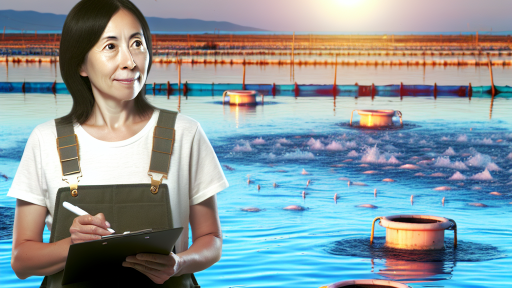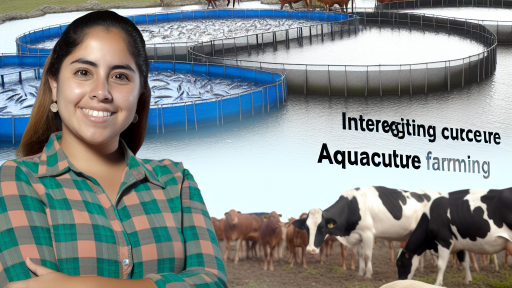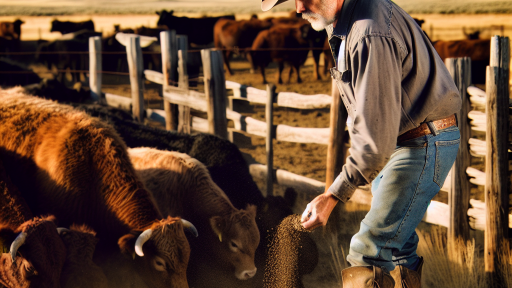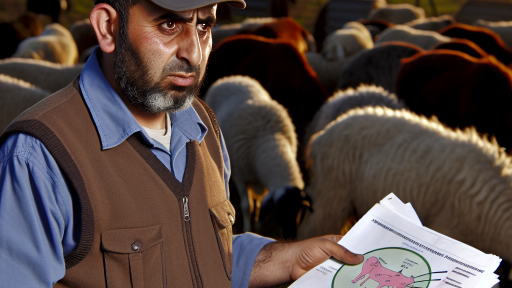Introduction to Fish Farming and Its Importance
Fish farming, also called aquaculture, significantly contributes to global food production.
This industry provides a consistent supply of fish to meet growing consumer demand.
It plays a crucial role in food security and economic stability.
Moreover, fish farming helps reduce pressure on wild fish populations.
Consequently, it aids in preserving biodiversity in our oceans and rivers.
Fish farming can take place in various settings, including freshwater and marine environments.
There are several farming methods, such as pond culture and cage farming.
Each method has distinct benefits and challenges regarding sustainability and environmental impact.
Through responsible practices, fish farming has the potential to benefit both communities and ecosystems.
In recent years, the focus has shifted towards sustainable aquaculture practices.
This shift aims to minimize harmful environmental impacts while maximizing production efficiency.
Therefore, understanding these practices is essential for future advancements in the industry.
Fish farming serves as an integral piece of the global food system.
It balances efficiency with the responsibility of protecting our natural resources.
Overview of Environmental Impacts
Water Pollution and Eutrophication
Fish farming significantly contributes to water pollution.
Transform Your Agribusiness
Unlock your farm's potential with expert advice tailored to your needs. Get actionable steps that drive real results.
Get StartedIt often involves the use of fertilizers and feed that leach into waterways.
This leads to the proliferation of nutrients in aquatic systems.
Eutrophication occurs as excess nutrients stimulate algae growth.
Harmful algal blooms can deplete oxygen levels in water bodies.
Consequently, aquatic life struggles to survive in these conditions.
Moreover, fish waste and uneaten feed accumulate, further polluting water.
The resultant imbalance disrupts local ecosystems and biodiversity.
This environmental degradation can affect local fishing industries.
To mitigate these impacts, sustainable practices are essential.
Efforts can include better waste management and feed efficiency.
Moreover, implementing buffer zones can help filter runoff before it enters waterways.
This approach reduces nutrient loads while promoting healthier ecosystems.
Using integrated multi-trophic aquaculture can also aid in this effort.
This system utilizes different species to break down waste products.
Furthermore, regular monitoring can help identify pollution hotspots.
Taking such proactive measures can lead to improved water quality.
Ultimately, adopting sustainable fish farming practices benefits both the environment and industry.
Impact on Wild Fish Populations
Overfishing
Fish farming can contribute to overfishing in natural waters.
Farmed fish species often compete with wild populations for food and habitat.
In some regions, this leads to a decline in wild fish stocks.
Overfishing disrupts the balance of marine ecosystems.
Consequently, it may result in the extinction of vulnerable species.
To combat overfishing, sustainable fishing practices are essential.
Regulations must be enforced to protect wild fish populations.
Showcase Your Farming Business
Publish your professional farming services profile on our blog for a one-time fee of $200 and reach a dedicated audience of farmers and agribusiness owners.
Publish Your ProfileGenetic Interference
Fish farming can cause genetic interference with wild populations.
Farmed fish often escape into the wild, introducing non-native genes.
This gene mixing affects the genetic diversity of wild stocks.
Reduced genetic diversity makes wild fish more susceptible to disease.
Moreover, it hinders their ability to survive environmental changes.
Effective measures are needed to prevent farmed fish from escaping.
In particular, using properly designed nets and containment systems is crucial.
Additionally, genetic screening can help ensure farmed fish do not interbreed with wild species.
See Related Content: Disease Prevention and Health Management in Fish Farms
Effect on Local Ecosystems
Habitats and Biodiversity Loss
Fish farming significantly impacts local ecosystems.
It alters natural habitats, disrupting established communities.
As fish farms expand, they introduce various environmental stresses.
These stresses can lead to biodiversity loss over time.
Additionally, fish farms often require substantial land and water resources.
This demand competes with natural ecosystems for vital resources.
Alteration of Water Quality
Fish farming can degrade water quality in nearby habitats.
Excess nutrient runoff contributes to harmful algal blooms.
These blooms reduce oxygen levels, harming local fish species.
Furthermore, fish excrement can introduce pathogens into the water.
Such pathogens threaten both wild fish populations and biodiversity.
Introduction of Invasive Species
Fish farms occasionally breed non-native species.
These species can escape into local waterways and establish themselves.
Once introduced, they often outcompete native species for resources.
As a result, this can further diminish local biodiversity.
Preventing escapes is crucial for maintaining ecosystem integrity.
Mitigating Habitat Loss
To mitigate habitat loss, sustainable practices must be prioritized.
Implementing stricter regulations can help manage farm locations.
Moreover, integrating sustainable feed sources can reduce nutrient runoff.
Monitoring fish health and farm operations also proves beneficial.
Engaging local communities in conservation efforts fosters awareness.
Protecting Natural Habitats
It is essential to protect nearby natural habitats from expansion.
Buffer zones between fish farms and ecosystems create essential barriers.
These zones help maintain water quality and habitat stability.
Promoting traditional fishing methods can also support local communities.
Furthermore, conservation programs can revitalize affected areas.
See Related Content: Top Fish Species for Successful Aquaculture Operations
Resource Use in Fish Farming
Water Usage in Aquaculture
Fish farming relies heavily on water resources for operation.
Freshwater and seawater both serve as crucial components for various aquaculture systems.
However, over-extraction of water can lead to ecosystem degradation.
This impact threatens native species and reduces water quality.
Showcase Your Farming Business
Publish your professional farming services profile on our blog for a one-time fee of $200 and reach a dedicated audience of farmers and agribusiness owners.
Publish Your ProfileEfficient water management practices can mitigate these risks.
Land Use Considerations
Aquaculture requires significant land for ponds and facilities.
Site selection affects local ecosystems and biodiversity.
It is essential to consider the land’s previous usage and natural habitats.
Implementing integrated multi-trophic aquaculture helps utilize resources effectively.
This strategy reduces land stress by promoting symbiotic relationships among species.
Feed Sources and Sustainability
Sustainable feed sources are vital for responsible fish farming.
Fishmeal and fish oil derived from wild catches can deplete marine stocks.
Using plant-based feeds can alleviate these pressures.
Innovation in alternative proteins is gaining traction in aquaculture.
Researching and developing sustainable feed options improves the industry’s outlook.
Strategies for Reducing Resource Impact
Implementing best management practices is essential for minimizing resource use.
Technologies such as recirculating aquaculture systems can enhance efficiency.
Regular monitoring of water quality and levels assures sustainability.
Collaboration with environmental organizations can lead to effective resource management.
By adopting these strategies, fish farming can support both industry and ecology.
Discover More: Breeding Strategies for Sustainable Livestock Farming
Mitigation Strategies
Adopting Sustainable Feed Practices
Sustainable feed practices significantly reduce the environmental impact of fish farming.
Using locally sourced ingredients minimizes transportation emissions.
Additionally, integrating plant-based feeds lessens the reliance on fishmeal.
This practice conserves marine resources and promotes biodiversity.
Implementing Integrated Multi-Trophic Aquaculture
Integrated Multi-Trophic Aquaculture (IMTA) combines different aquaculture species in one system.
This approach enhances nutrient cycling within the ecosystem.
For instance, seaweed can absorb excess nutrients from fish waste.
Consequently, IMTA improves water quality and overall production efficiency.
Utilizing Efficient Water Management Techniques
Efficient water management is crucial for sustainable fish farming.
Recirculating Aquaculture Systems (RAS) reduce water usage dramatically.
These systems filter and reuse water, minimizing waste discharge.
Furthermore, monitoring water quality ensures a healthier environment for fish.
Promoting Certification and Eco-labeling
Certification and eco-labeling encourage responsible fishing practices.
Organizations like the Marine Stewardship Council promote sustainable fisheries.
Farmers adopting certified practices gain market advantages.
Consumers, in turn, support sustainable products with their purchases.
Engaging in Community Education and Outreach
Community education plays an essential role in sustainable fish farming.
Workshops and training increase awareness of best practices.
Farmers benefit from knowledge-sharing opportunities with experts.
Moreover, informed consumers are more likely to choose sustainable options.
Incorporating Technological Innovations
Technological innovations can greatly enhance sustainability in aquaculture.
For example, automated feeding systems reduce waste and improve efficiency.
Monitoring technologies allow for real-time assessment of fish health.
Showcase Your Farming Business
Publish your professional farming services profile on our blog for a one-time fee of $200 and reach a dedicated audience of farmers and agribusiness owners.
Publish Your ProfileAdditionally, drones and satellite imagery facilitate better farm management.
Find Out More: Preventing Genetic Diseases in Livestock
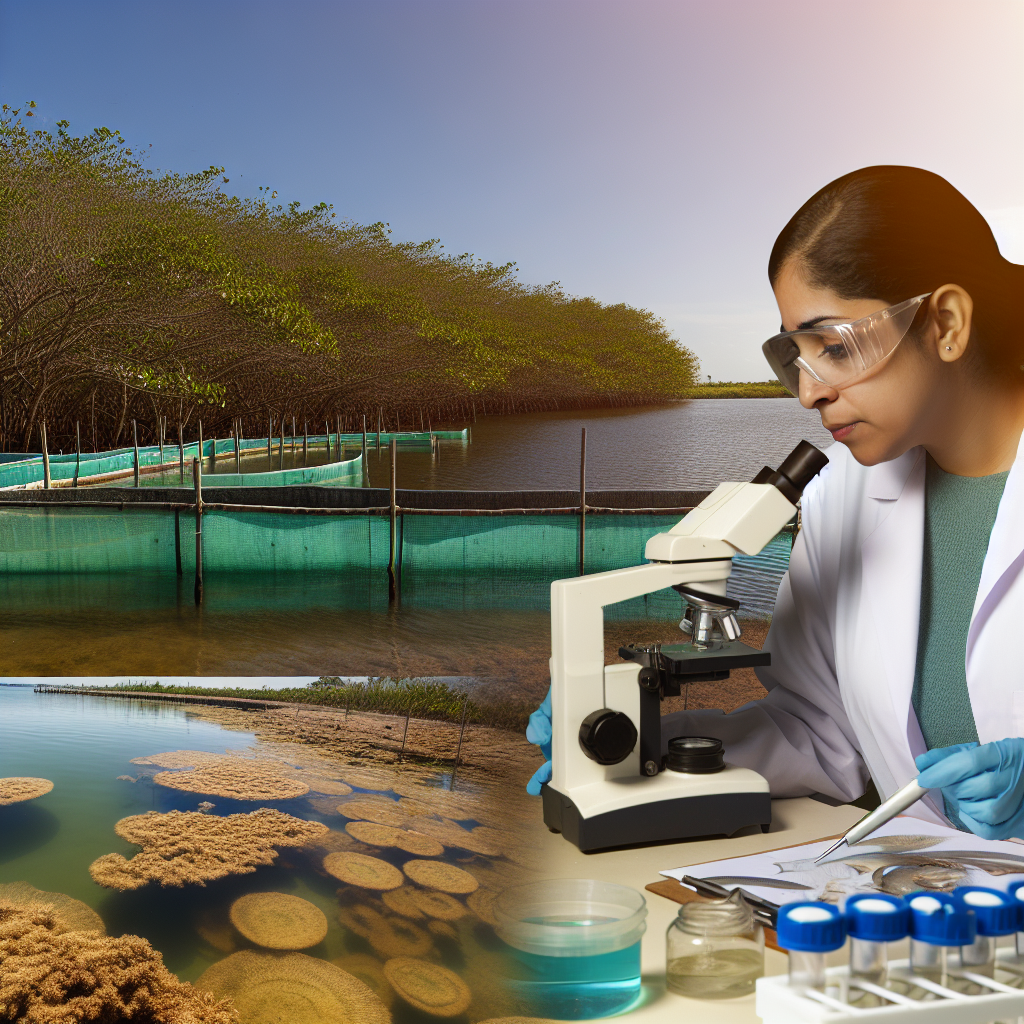
Innovative Technologies for Reducing Environmental Footprint
Aquaponics Systems
Aquaponics integrates aquaculture and hydroponics to create sustainable systems.
This method recycles water and nutrients effectively across different organisms.
Fish waste provides essential nutrients for plants, reducing fertilizer needs.
In turn, plants purify the water for fish, enhancing water quality.
Recirculating Aquaculture Systems
Recirculating aquaculture systems (RAS) drastically decrease water use.
These systems filter and reuse water continuously, minimizing waste discharge.
Moreover, RAS allows for year-round production in controlled environments.
This control helps reduce the spread of diseases significantly.
Biological Filtration Techniques
Biological filtration employs microbes to break down harmful waste in fish farming.
Using natural processes enhances water quality without harmful chemicals.
Furthermore, this technique helps regulate nutrient cycles effectively.
Use of Probiotics
Probiotics can improve fish health and reduce disease outbreaks.
These beneficial bacteria help enhance water quality naturally.
Additionally, probiotics can support the immune system of farmed fish.
Sustainable Feed Alternatives
Utilizing sustainable feed sources can greatly reduce environmental impacts.
Plant-based feeds are becoming increasingly popular as alternatives to fishmeal.
These innovative feeds help decrease overfishing pressure on wild stocks.
Efficient Waste Management Systems
Advanced waste management technologies minimize the ecological footprint of fish farms.
Using digesters can convert waste into energy, creating a closed-loop system.
This approach benefits energy production and reduces environmental pollution.
Case Studies of Successful Sustainable Fish Farming Operations
GreenWave Aquaculture
GreenWave Aquaculture exemplifies a successful organic fish farming model.
They utilize a multi-trophic approach to optimize resources.
This method incorporates shellfish and seaweed to enhance ecosystem health.
GreenWave minimizes feed inputs while maximizing biodiversity.
By replicating natural ecosystems, they ensure sustainability.
Blue Ocean Fish Farm
Blue Ocean Fish Farm is renowned for its innovative technology.
They employ recirculating aquaculture systems to conserve water.
This process reduces water usage by up to ninety percent.
Additionally, they focus on sourcing feed from sustainable sources.
This farm promotes responsible aquaculture practices across the industry.
Ocean Harvesters
Ocean Harvesters focuses on offshore fish farming to reduce land impacts.
They cultivate fish in deep ocean waters, ensuring cleaner environments.
By relocating farms offshore, they minimize interactions with coastal ecosystems.
Thus, they promote ecological integrity while ensuring high-quality fish.
EcoAquaculture Solutions
EcoAquaculture Solutions integrates automation in their operations.
This technology increases efficiency and reduces labor costs.
They monitor water quality and fish health with advanced sensors.
As a result, they maintain optimal conditions for fish growth.
Showcase Your Farming Business
Publish your professional farming services profile on our blog for a one-time fee of $200 and reach a dedicated audience of farmers and agribusiness owners.
Publish Your ProfileFurthermore, they emphasize community engagement and education programs.
Riverbank Aquaponics
Riverbank Aquaponics combines fish farming with vegetable production.
This integrated system uses fish waste to nourish plants naturally.
Consequently, they create a closed-loop system that conserves resources.
This approach enhances food security while minimizing environmental impacts.
Additionally, Riverbank engages local communities in sustainable practices.
Balancing Fish Farming Growth with Environmental Health
Understanding the Environmental Effects
Fish farming significantly impacts local ecosystems.
It can lead to water pollution from waste and chemicals.
This pollution often affects surrounding water bodies.
Consequently, it can harm aquatic life and biodiversity.
Moreover, fish farming can promote the spread of diseases.
These diseases can transmit to wild fish populations.
Additionally, the overuse of antibiotics in fish farming raises health concerns.
This practice may contribute to antibiotic resistance.
Furthermore, the introduction of non-native fish species disrupts local ecosystems.
Mitigation Strategies
Implementing responsible fish farming practices can mitigate environmental impacts.
Firstly, farmers can adopt integrated multi-trophic aquaculture.
This approach promotes biodiversity and sustainability.
Secondly, regular water quality monitoring helps detect problems early.
This practice ensures that pollution levels remain controlled.
Using sustainable feed sources also reduces negative impacts.
Farmers should opt for plant-based feeds and innovative feed alternatives.
Additionally, rotating fish species can enhance ecological balance.
Finally, educating farmers about sustainable practices is crucial.
This knowledge empowers them to implement better methods.
The Role of Policy and Community Engagement
Government policies play a vital role in sustainable fish farming.
Regulations should be enforced to ensure environmental protection.
Support from local communities can lead to significant changes.
Engaging with stakeholders fosters collaboration for better practices.
Furthermore, promoting transparency in fish farming boosts consumer confidence.
Consumers can make informed choices for sustainable seafood.
Public awareness campaigns can drive change within the industry.
Future Directions for Sustainable Practices
The future of fish farming lies in innovation and sustainability.
Research into new aquaculture technologies can enhance productivity.
Moreover, developing eco-friendly farming techniques is essential.
Establishing stricter regulations will protect the environment.
Collaboration between researchers and farmers will lead to breakthroughs.
Incorporating circular economy principles can also be beneficial.
This approach minimizes waste and recycles resources efficiently.
Ultimately, balancing fish farming growth with environmental health is crucial.
Showcase Your Farming Business
Publish your professional farming services profile on our blog for a one-time fee of $200 and reach a dedicated audience of farmers and agribusiness owners.
Publish Your ProfileIt ensures a sustainable future for both the industry and our ecosystems.
Additional Resources
Chapter 5 : Food Security — Special Report on Climate Change and …
If done correctly, aquaculture increases food production, boosts …

